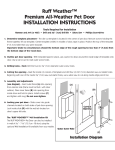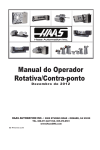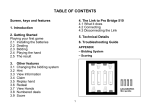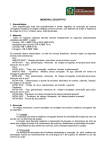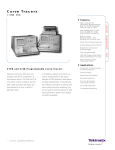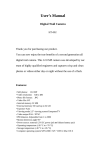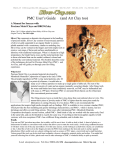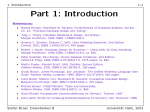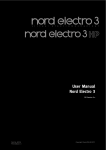Download Switches - Mr Bridge
Transcript
JULIAN POTTAGE on DEFENCE West I ♠ ♥ ♦ ♣ AQJ3 A8 K 10 7 5 K87 N W E S West Pass End North 1♦ 3♠ ♠ ♥ ♦ ♣ 765 J9652 J963 A East Pass Pass South 1♠ 4♠ Partner, West, leads the queen of clubs, and declarer plays low from dummy. You win faultlessly with your ace. What do you return? HALLMARKED PENCILS The fact that you have used your ace other than to capture dummy’s king makes your singleton obvious to the other two players. What you would like to do is to put partner in before trumps are drawn, and hope to ruff dummy’s king of clubs. With the ace of hearts visible in dummy, you know that switching to heart will not achieve the objective of getting partner in quickly, so you should lead a small diamond. The full deal may look like this: ♠ ♥ ♦ ♣ ♠ ♥ ♦ ♣ 8 Q74 A842 Q J 10 5 4 AQJ3 A8 K 10 7 5 K87 N W E S ♠ ♥ ♦ ♣ ♠ ♥ ♦ ♣ 765 J9652 J963 A K 10 9 4 2 K 10 3 Q 9632 Partner can capture the queen of diamonds with the ace and revert to clubs, probably leading the jack. If dummy plays low, you will discard and wait to ruff the third round. In practice declarer calls for the king, so you ruff. Having scored your ruff, you passively exit with a trump and hope your opponent must concede a club at the end. Let us see another example on which you have no choice but to change suit: ♠ ♥ ♦ ♣ AKJ753 Q8 10 7 3 J8 Boxed set of four in Silver £125 also available in 9ct or 18ct gold. Mail Order Service. See centre pages. East Pass 2♥2 Pass 3♠ End 1 12-14 2 Transfer to spades Switches n the last issue you may recall that we discussed why the defenders often persevere with the suit they led at trick one. Now we will see some reasons for switching suits. The best excuse for opening up a new suit is that you have run out of the suit originally led. North N W E S ♠ ♥ ♦ ♣ 82 K 10 5 4 2 Q92 K 10 4 Page 27 Pass Pass South 1NT 1 2♠ 4♠ West leads the ace of diamonds and, when you encourage with the nine, continues with the king and a low diamond. South, who had started with J-x-x of the suit, follows three times. With 19 points between your hand and dummy, and South with 12-14, West must have 7-9. Since you have already seen the ace and king of diamonds (7 points), partner can have at most a jack or queen left. This means that you cannot score a fourth trick quickly, so you want to bide your time and give nothing away. The riskiest lead is a heart. If the success of the contract depends on it, declarer will let a heart run round to dummy and the queen will score. A club is almost as bad. Whilst it might give nothing away if West has the queen, the odds are that South has more than 12 points (in order to accept the game invitation), so is likely to hold the queen of clubs. In this case, a club lead round to the jack allows declarer to make three club tricks: the jack now and, by means of a finesse, the ace and queen later. A trump is the safe exit. Even if West unexpectedly has Q-x, your opponent could always pick up the suit either by playing for the drop or by taking the finesse. This is the full deal: ♠ ♥ ♦ ♣ ♠ ♥ ♦ ♣ 6 J963 AK64 9752 AKJ753 Q8 10 7 3 J8 N W E S ♠ ♥ ♦ ♣ ♠ ♥ ♦ ♣ 82 K 10 5 4 2 Q92 K 10 4 Q 10 9 4 A7 J85 AQ63 After your passive trump return, declarer has only nine tricks: six trumps, two clubs and a heart. Continued on page 28 ❿ MODERN AMERICAN BIDDING POTTAGE ON DEFENCE continued from page 27 When the Dummy is on Your Right . . . ♠ ♥ ♦ ♣ K93 A 10 3 82 K Q 10 8 3 ♠ ♥ ♦ ♣ N W E S Eric Kokish and Beverly Kraft – two of the world’s leading bidding theoreticians, writers, teachers and International coaches, with impressive playing credentials – present a cohesive system with treatments aimed at improving constructive Standard American bidding. As well as demonstrating the correct application of partnership agreements, the deals focus on important aspects of expert evaluation and judgement. The program consists of 200 prepared deals, which the user bids as South. The bids selected are evaluated and commented upon; if your PC has a sound card and speakers you can hear the explanations of the presenters; otherwise, they are shown as text on the screen. After the bidding, you may play the hand. The software, which is aimed at ambitious players hoping to hone their game, is supported with a system summary and a user manual. TOPICS COVERED Minor suits facing balanced openers Smolen Jacoby transfers Texas transfers Inverted minor raises Developments after two-over-one responses Semi-forcing 1NT responses Third- and fourth-suit auctions Controls and long-suit responses to 2♣ Improved continuations after opener’s balanced rebids Bidding after a reverse Improved Drury continuations £79.95 inclusive of postage & packing By Swift Air to the US US$129.95 from the Mail Order Service System Requirements: Windows 98, ME, 2000, XP, CD-ROM West North Pass Pass 2♣ 4♥ A Q J 10 5 Q6 J 10 7 4 95 East Pass 2♠ End South 1♥ 3♣ West leads the six of spades and your ten wins the first trick. You could continue spades – but would it be wise? To continue with ace and another spade would be ill advised. The bidding suggests that South has five hearts and four clubs, so is far more likely to hold two spades than three. Even if partner could ruff the third round of spades, it might be at the cost of a trump trick. The usual rule, especially when you can see dummy on your right, is to lead up to known weakness. You have not been able to apply that on the previous hands because dummy had no obviously weak suit. Here it does: diamonds. A switch to the jack of diamonds could beat the contract in a variety of ways. For one thing, West may produce the ace and queen of diamonds. Then, unless South holds a singleton, you will be able to score the first four tricks with two spades and two diamonds. The diamond switch should also work well if West has the king, the full deal being: ♠ ♥ ♦ ♣ ♠ ♥ ♦ ♣ 764 J84 K9653 J6 K93 A 10 3 82 K Q 10 8 3 N W E S ♠ ♥ ♦ ♣ ♠ ♥ ♦ ♣ 82 K9752 AQ A742 Page 28 A Q J 10 5 Q6 J 10 7 4 95 After the diamond lead through the acequeen, your opponent cannot avoid losing two spades, a diamond and a trump. If you mistakenly continued spades or tried a club, declarer would be able to discard the queen of diamonds on a black winner, and so avoid losing a diamond. If partner had the ace of clubs (instead of the jack of hearts) and the king of diamonds, the diamond switch would produce a similarly useful result: setting up a fourth defensive winner. Swap Places with Partner The time has come to move to the West chair: ♠ ♥ ♦ ♣ West Pass End ♠ ♥ ♦ ♣ 10 2 84 KQJ875 K Q 10 983 K Q 10 9 7 A3 J94 North 1♦ 2♦ N W E S East Pass Pass South 1♠ 3NT As the opening leader, you cannot see either weakness or tenace holdings on your right, and you often need to rely on signals from partner and/or logical powers of deduction. Here you lead the king of hearts. This wins the trick but East follows with the two – clearly a discouraging card. You place South with both the ace and jack of hearts, making a continuation futile. You want to put partner in to lead a heart before your ace of diamonds entry is knocked out. Which black suit should you lead? Since declarer has bid spades, and presumably holds strength in the suit, it may seem natural to try a club, but logic actually points the other way. To jump to 3NT your opponent surely has some sort of stopper in both the unbid suits, hearts and clubs. Between your hand and dummy, you can see all the clubs down to the nine except for the ace. Continued on page 29 ❿ One Last Example POTTAGE ON DEFENCE continued from page 28 This makes it a near certainty that the ace of clubs lies on your right. Accordingly, you should switch to a spade – either the eight or nine will get across that you do not want a spade back. The full deal may look like this: ♠ ♥ ♦ ♣ ♠ ♥ ♦ ♣ 983 K Q 10 9 7 A3 J94 10 2 84 KQJ875 K Q 10 N W E S ♠ ♥ ♦ ♣ ♠ ♥ ♦ ♣ AQ6 632 10 4 2 7653 KJ754 AJ5 96 A82 In a suit contract, you will often want to try a different suit if declarer or dummy has run out of your first suit and still has trumps left. This advice holds particularly true if both opponents have run out of the suit. ♠ ♥ ♦ ♣ ♠ ♥ ♦ ♣ 9865 KJ7 10 6 AK82 4 10 9 8 2 AKQJ83 10 9 N W E S West North East 2♦ End 3♠ Pass South 1♠ 4♠ You lead the ace of diamonds, and continue with the jack. Partner plays the two and then the nine on these. What should you lead to the next trick? With a doubleton diamond, you would normally expect partner to play highlow. The actual choice to play upwards therefore implies a three-card holding. If you play a third round, declarer can probably ruff in one hand and throw a loser from the other – not something you wish to facilitate. A trump lead can hardly help, and might catch East with Q-x-x, so which other suit do you try? Dummy’s hearts are shorter and weaker than its clubs, so there is less chance that declarer can throw clubs on hearts than the other way round. In any event, if partner has a club winner, it will be a slow one and whether you lead the suit now is almost certainly immaterial. The lead that stands out is the ten of hearts. This cannot give anything away and, on a good day, you will find partner with the ace and queen. Indeed, as we will discuss in a future article, the nine of diamonds may well be a signal for hearts, making this layout quite plausible. This is the full deal: ♠ ♥ ♦ ♣ ♠ ♥ ♦ ♣ 9865 KJ7 10 6 AK82 4 10 9 8 2 AKQJ83 10 9 N W E S ♠ ♥ ♦ ♣ ♠ ♥ ♦ ♣ 10 7 AQ64 942 7643 AKQJ32 53 75 QJ5 ♠ ♥ ♦ ♣ K J 10 3 AK3 962 932 Duplicate Bridge Scoring Program for Windows 95 or later £52 95 inc p&p Single or multi section/session ♦ Any movement scored ♦ Enter names using initials Prints Master-points ♦ Uploads Sim Pairs results ♦ Creates HTML files Mail Order Service Page 29 ♠ ♥ ♦ ♣ N W E S AQ 8765 Q J 10 Q J 10 5 South opens a weak no-trump, and then proceeds to game when North makes an invitational raise with 2NT. West leads the seven of spades and you capture dummy’s jack with your queen. Returning a spade will only serve to set up dummy’s suit, so undoubtedly you wish to direct your attack elsewhere. This time dummy contains not one weak suit but two, so which do you try? Remember, when you are the opening leader against a no-trump contract, you often lead your longest suit, and you have reached an equivalent position here. If you had been on lead at trick one, you would have led the queen of clubs. There is nothing in dummy to suggest that a diamond will work better, so a club it should be. Another way to reach the same conclusion is to reflect on the fact that even if West has the king of diamonds and you lead a diamond now, then you are likely to score two spades and only two diamonds – not enough to defeat the contract. If, however, you lead a club and find West with the king, you may set up three club tricks, which will be enough. The full deal is illustrated below. Given half the chance, declarer can rattle off ten tricks, which makes it essential for the defenders to take all their winners quickly. SUPERSCORER From the At both suit and no-trump contracts, you may wish to switch if you can see that the opening lead has not hit declarer’s weak spot. Please move back to the East seat for our final example. ♠ ♥ ♦ ♣ ♠ ♥ ♦ ♣ 9754 10 4 7543 K74 K J 10 3 AK3 962 932 N W E S ♠ ♥ ♦ ♣ 862 QJ92 AK8 A86 ♠ ♥ ♦ ♣ AQ 8765 Q J 10 Q J 10 5 ■




